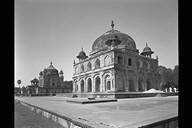Allahabad is situated at a place where the Ganga River flows down to the south and the eastwardly flowing Jamuna River meet. It is believed by Hindus that by bathing at this junction of two great rivers, they can purify their soul. Allahabad fort was constructed by the Emperor Akbar in 1584 at a site where the fork of the two rivers can be looked down upon. Khosrow Bagh is situated 5 km west of the fort. At the end of the Akbar reign, Prince Salim, who later on acceded to the throne as Emperor Jahangir, was living in the fort. (Naoko Fukami)
There is a park called Khosrow Bagh at the south side of the Allahabad station, in which can be found the tombs of Prince Khosrow, the eldest son of the 4th emperor of the Mughar Empire Jahangir, and his family. The name of this park came from him. (Matsuo Ara)
1.TOMB OF PRINCE KHUSRAU It is situated at the east end of the group of tombs. It is a tomb with a square plan which faced was articulated into two tiers, each wall having 10 arches. This building is at the east end of the three tombs on the basement, there is a fountain at the west side of the building and further west the other tombs line up. The inside wall of the basement is decorated with a large amount of Arabic poetry and paintings of trees and flowers but most of them have peeled off. There is a marble tombstone that entombs Prince Khusrau on the basement but there is no inscription on it. The two tombstones that are situated right and left of this majestic tombstone are said to be those entombing a son of Prince Khusrau. Prince Khusrau was called "tragic prince". He revolted against his father Emperor Jahangir in 1606, fighting for his succession. Later on he was entrusted to his brother Prince Khurram. It is said that he was buried here after his death in 1622. (Matsuo Ara)
2.Tomb of Shah BegamIt is situated in the middle of the three tombs on the basement. The tomb is built with a square highbasement and upper square tomb chamber which has a dome on top. There are kiosks at the four corners on the roof, a style which is often seen in Mugharid tombs. It is said that this tomb is for Shah Begam (d. 1624/25), a sister of Prince Khusrau. (Matsuo Ara)
3.Tomb of Nithar BegamOf the four tombs in Khosrow Bagh, this tomb is said to entomb Nithar Begam (d. 1605), the mother of Prince Khusrau and the Hindu Empress of Jahangir. It is twelve pillared tomb formed square with a pyramidal shaped roof on the higher foundation, situated at the third from the east, and the furthest west on the basement. This building looks simple, yet shows a unique structure and style among tombs in the Mugharid period. (Matsuo Ara)
4.Tomb of Tamblan Begam It is situated the westernmost of the tombs in Khosrow Bagh. On an octagonal basement, the octangler upper building is formed. Dr.Merklinger views this as a building from the early 17th century. (Matsuo Ara)
[
for more on this click here] [Source:
http://www.ioc.u-tokyo.ac.jp] [Click on respective names to view pictures]


